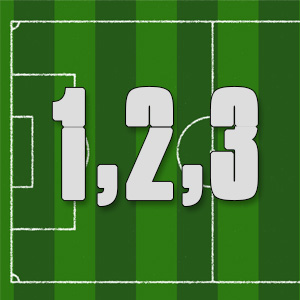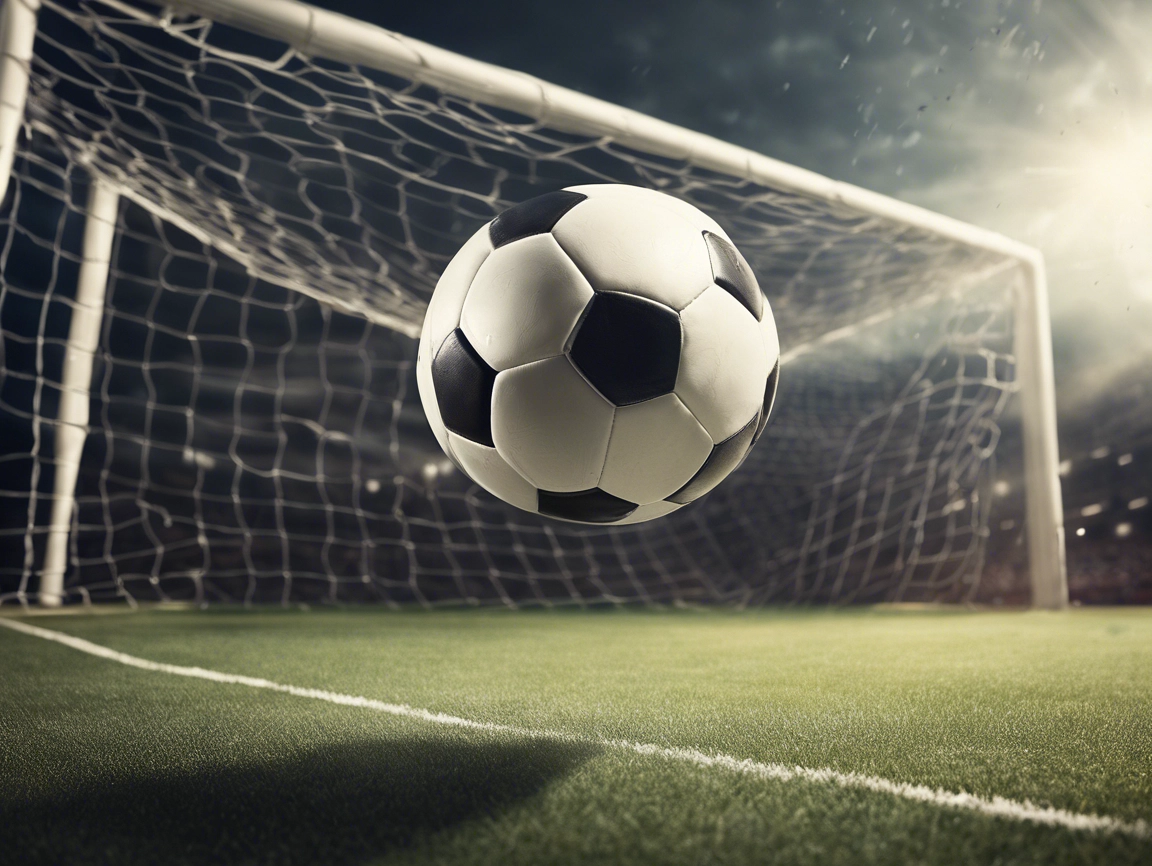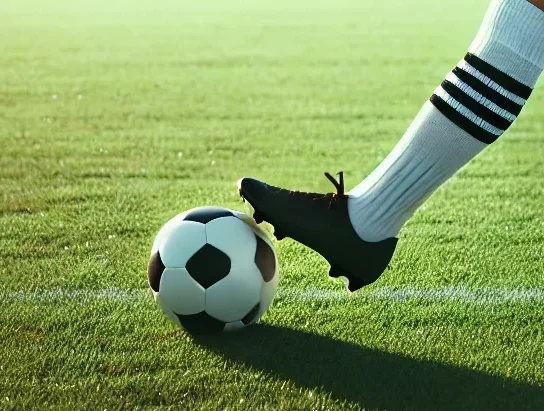The Offsides Rule Explained
Picture this! You’re watching your first World Cup final.You are on the edge of your seat. Suddenly, a player on your team bursts forward, running towards the goal; their teammate makes a beautifully weighted pass, and the player masterfully dribbles and shoots a beautiful ball into the top right corner. You jump to your feet cheering “YAY TOP BINS ( a term you just learned, here)!!” Your cheers are short lived and stopped by raised flags and the referee’s piercing whistle. Offsides! What!?! But how!?! What does that even mean?
Most soccer newcomers find offsides a mystery. So, let’s break it down in a way that’s easy to grasp.
Why does the rule of offsides exist?
The offside rule prevents players from gaining an unfair advantage by positioning themselves closer to the opponent’s goal line. So, players aren’t just hanging out by the goal, waiting for the ball to be played to them. It promotes strategic play, teamwork, and skillful ball movement. Imagine a team’s strikers just standing by the goalie for 90 minutes; it would make for a pretty boring match. And a pretty mad goalie.
When is a player offside?
A player is offside if they are closer to the opponent’s goal line than both the ball and the second-to-last defender when the ball is played to them, and they are involved in active play.
A few conditions need to occur simultaneously for the offside flag to be raised.
Positioning:
A player is considered offside if they are closer to the opponent’s goal line than both the ball and the second-to-last opponent (usually the last outfield player or the goalkeeper). So, if we look at the image below the last defender would be the goalie, Mary Earps. The second to last defender would be Leah Williamson. Alexia (attacking midfielder) is playing the ball to Aitana Bonmati (attacker), but Bonmati is ahead of Leah Williamson, so she is offsides.
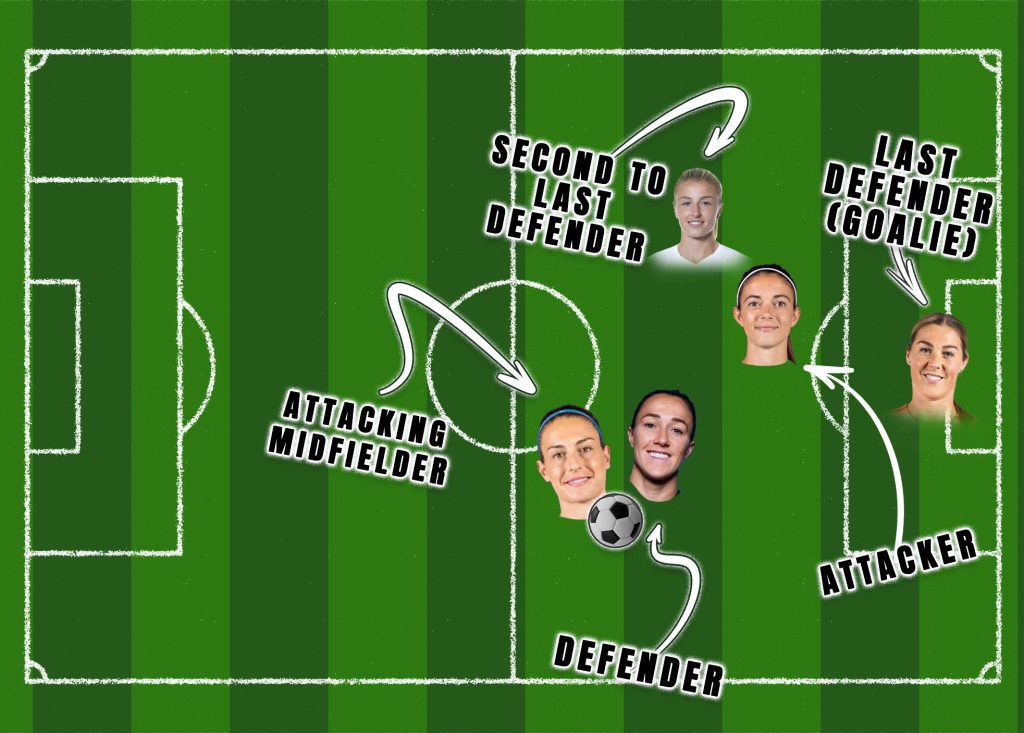
It’s important to note that being in an offside position alone does not constitute an offense. It’s only when a player becomes involved in active play from that offside position that the offside offense occurs.
Involvement:
A player is considered to be involved in active play if they:
- Gain an advantage by being in that position (e.g., receiving a pass or interfering with an opponent).
- Interfere with an opponent by obstructing their line of vision, challenging them for the ball, or distracting them in any way.
- Gain an advantage by being in that position and subsequently becoming involved in the play, even if the ball is played to them unintentionally by a teammate.
Let’s look at the same image, say Alexia decides to take the ball to goal herself and Bonmati removes herself from the play by jogging away from goal. Then there would be no offside call.
Moment of the Pass:
The offside offense is judged at the exact moment a teammate plays the ball to the player in the offside position.
If, at that moment, the player is in an offside position and involved in active play, the assistant referee (or VAR in professional matches) will raise the flag or signal for offside.
In this example, Bonmati (attacking midfielder) played a ball to Alexia (attacker) while Alexia was behind Leah Williamson (the second to last defender). As long as Alexia is behind Leah up until the point Bonmati plays the ball she will be onsides, but if even her toe is beyond where Leah is, she will be offsides.
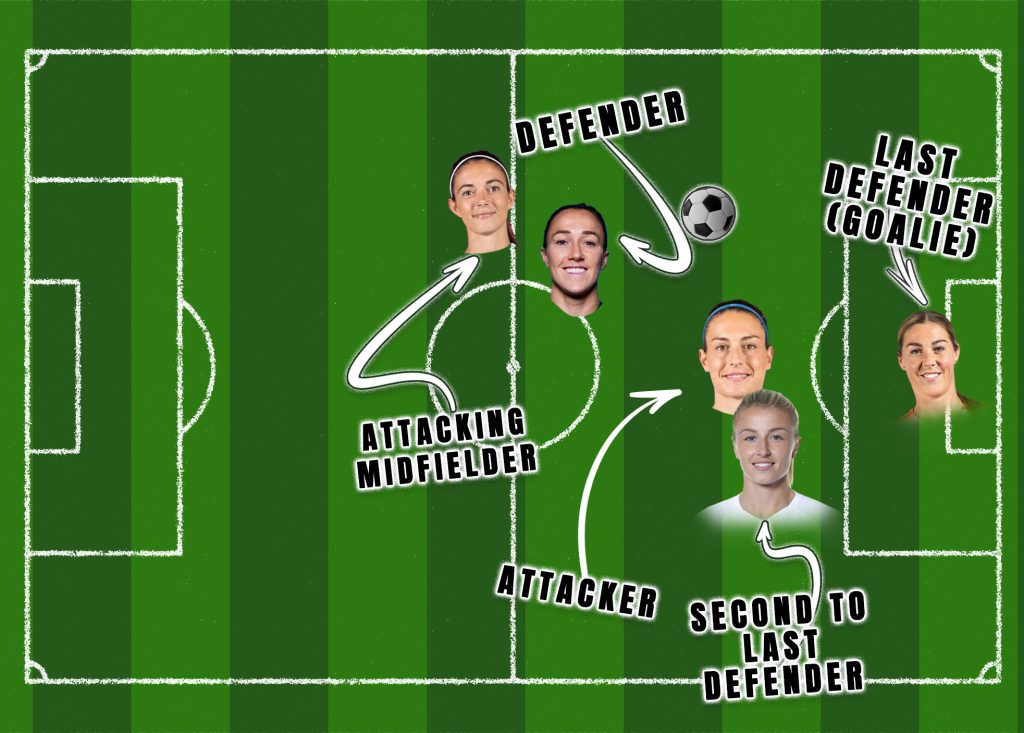
Keep in mind that it doesn’t matter how much of an attacker’s body is beyond the second-to-last defender. It can be half of the attacker’s body, the whole body or even the tip of their toe. No part of their body, excluding the hands and arms (of all players, even the goalie, ) can’t be past that invisible line.
Who and how is the offside call made?
Unlike other soccer rules, offsides aren’t always as clear-cut as a handball or a foul. They involve invisible lines and split-second judgments, making them tricky to spot in the heat of the moment.
Referees and assistant referees (linesmen/lineswomen) make offside decisions by closely observing the positioning of players in relation to the ball and the second-to-last defender at the moment the ball is played. Here’s how they manage to make these split-second decisions:
Positioning: Assistant referees position themselves along the touchlines to get the best view of the action. They constantly scan the field, focusing on the movement of players and the ball. If you wonder why someone with a flag is sprinting up and down the sideline, this is why. They try to be in the best position to make a call by aligning themselves with the play.
Focus on Key Areas: Assistant referees pay particular attention to key areas of the field where offside situations are most likely to occur, such as near the opponent’s goal.
Line of Vision: They maintain a clear line of vision between themselves, the players, and the action. This allows them to judge players’ positions in relation to the offside line accurately.
Communication: Assistant referees communicate with the referee using hand signals or electronic communication devices to indicate when they believe an offside offense has occurred.
Experience and Training: Referees and assistant referees undergo extensive training to develop their ability to make quick and accurate decisions during a match. They also gain valuable experience through officiating games at various levels of competition.
Teamwork: Just like the teams in the games, Referees and assistant referees work as a team to monitor the game and make decisions collaboratively. They rely on each other’s observations and signals to ensure fair and consistent officiating.
What is the penalty for being offside?
When a player finds themselves caught offside, it’s time to face the consequences. The referee blows the whistle, the flag goes up, and the game screeches to a halt. The guilty party is penalized with an indirect free kick given to the opposing team from the spot where the offside offense occurred.
But here’s the kicker: this isn’t your ordinary free-kick scenario. Nope, it’s an Indirect Free Kick, which means the ball must touch another player before it can find its way into the net. It’s like a game of soccer chess, where every move counts, and one wrong step can lead to a costly setback.
What is VAR?
Despite the best efforts of referees and assistant referees, offsides can sometimes come down to a matter of interpretation. Was the player truly interfering with play from an offside position, or were they merely in the wrong place at the wrong time? This is where VAR or video assist referees come in (although they are not available in all leagues, games, or tournaments).
VAR is like having a special team of referees watch the game from different angles on video screens. When something important happens, like a goal or a penalty, the main referee can ask the VAR team to take a closer look. They check the video footage to make sure they make the right decision.
VAR focuses on a few main things: goals, penalties, and red cards. By reviewing these moments, VAR helps ensure the game is fair for both teams.
If you have watched any major tournament in the last year, you have seen some VAR decisions. For example, in the 2019 Women’s World Cup, when the USA was penalized for fouling an England player at the goal line, or in the 2023 Women’s World Cup when VAR was used to determine if Sweden’s final penalty kick crossed the goal line.
However, sometimes, using VAR can slow down the game because reviewing the footage takes time. Even though VAR helps referees, sometimes people disagree with its decisions.
Sometimes it’s a trap!
Defensive teams often employ a tactic known as the offside trap to catch attacking players in offside positions. This tactic involves defenders stepping up in unison to catch attacking players offside as the ball is played forward. It requires precise timing and coordination among defenders to execute effectively.
When executed to perfection, the offside trap is a thing of beauty, leaving the attackers stranded in no man’s land, desperately trying to beat the invisible barrier of the offside line.
Let’s look at some real life examples!
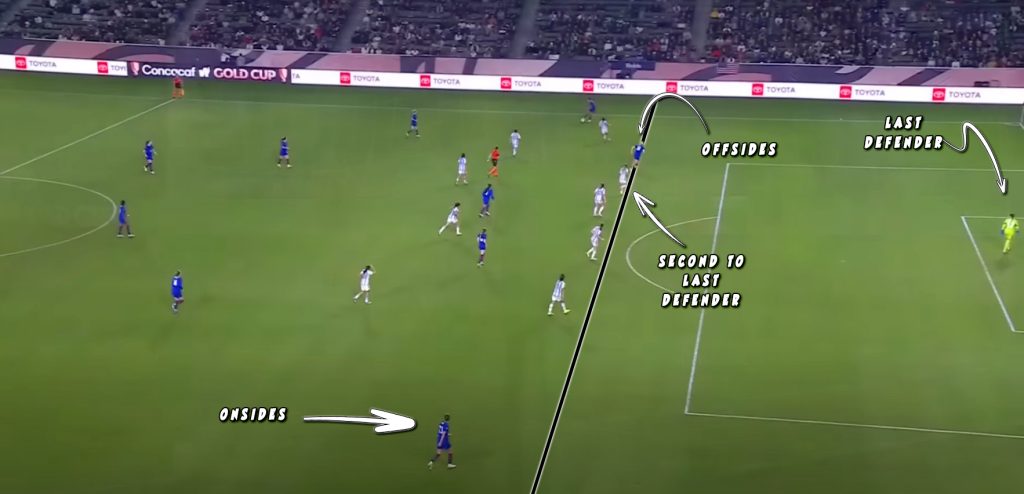
In this still you can see at the top of the image that the player is barely past the second to last defender. The player at the bottom of the image would be onsides, so, if the ball was played to her and the offside player removed herself from the play the team could continue forward. If the ball is played to the offside player then the flag will be raised.
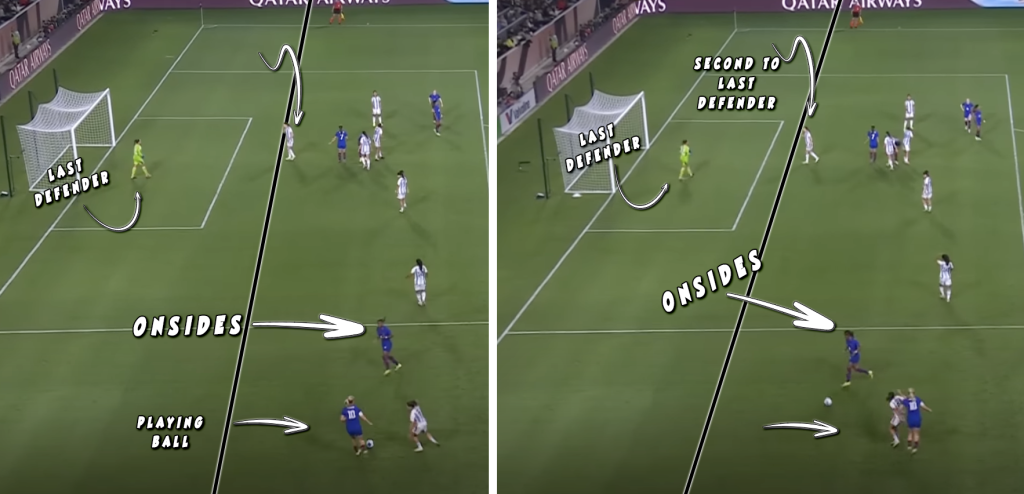
In the example above you can see the second to last defender is closer to the last defender (the goalie) than anyone on the opposing (blue) team. So, all player would be onside when the ball was passed.
Offsides may not be the most thrilling aspect of the game, but they’re a crucial rule that keeps things fair on the pitch. Understanding the offside rule is essential for enjoying and playing soccer. While it may seem confusing at first, with practice and a clear understanding of the basics, you’ll soon master this important aspect of the game. So, get out there, have fun, and remember to play fair!
Soccer is a beautiful game that rewards skill, teamwork, and sportsmanship. Knowing the rules, like offsides, only enhances the experience. Whether you’re cheering from the sidelines or dribbling on the field, may your soccer journey be filled with excitement and success!


